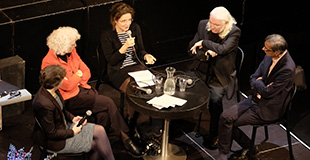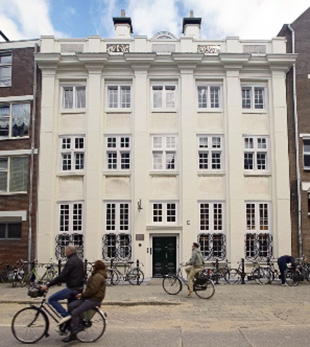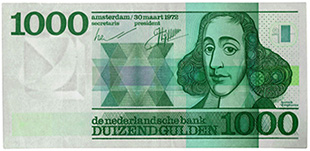Possible causes of underappreciation in Amsterdam
• His birth house in Amsterdam has disappeared, the Jewish quarter has been demolished, now there is the Waterlooplein and the Stopera.
• He has been buried in The Hague.
• In The Hague already stands a statue.
• His remained homes stand in Rijnsburg and The Hague.
• He was a Jewish man.
• Problematic relation with the Jewish community concerning his banishment. That is no reason to be proud of.
• Problematic relation with Amsterdam, because Spinoza has been in fact chased off by the influential reformed church, Cartesians and the burgomasters of Amsterdam. That is no reason to be proud of.
• The association of Spinoza with the tolerant republican Grand Pensionary Johan de Witt, who was murdered by reformed, Orangistic agitators in 1672 in an atrocious manner.
• Resistance over the centuries from religious angle, because of alleged atheism.
• Denunciation, demonisation, criminalization, as a result of which a dark atmosphere of illegality, sin, hell and damnation kept hanging around him.
• Consequence of all this is that he was for a long time considered to be a dissident.
What has Amsterdam to do with Spinoza?
• For Spinoza himself Amsterdam was a very special city, which becomes clear in the Theologico-Politico Treatise, p. 434: “The smaller the freedom of expression of opinion is in a state, (...) the more violent she is governed. I do not have to look for examples, which I can use to show that from this freedom no abuses arise that the highest power cannot prevent and that this authority cannot hold back people doing each other damage, although they openly have a contrary opinion. Amsterdam for example reaps the benefits of this freedom hence its growth, which all nations admire. In this thriving and favoured city state people from all nations and with all possible beliefs live together harmoniously. (...) Other than that one does not worry himself for the belief or the sect, because they are not important in the courtroom. No belief is so much loathed that the followers are not helped and protected by the magistrate (judge, government ), provided that they do not harm anybody, give everyone what belongs to him and live decently.”
• Spinoza was born in 1632 in the Jewish quarter of Amsterdam and he left Amsterdam in 1660-1661. He therefore lived here until his 28th. He died 17 years later in 1677, aged 44, and we can therefore state that he lived the largest part of his life in Amsterdam.
• In this city he has grown up, he has got a Jewish education and here he has naturalised. Amsterdam was then the influential economic, cultural and philosophical centre of the world. Moreover, nowhere in the world was as much freedom of expression of opinion and religious tolerance as in the multicultural Amsterdam. Nowhere so much was discussed about religious, philosophical and political matters as here.
• In Amsterdam Spinoza started doubting to the religious dogmas and he developed his ideas, what among other reasons led to his banishment from the Jewish community in 1656. Jarich Jelles wrote later that Spinoza in 1654 already studied the works of Descartes (who also lived in Amsterdam for a long time).
• From a report of the Spanish Inquisition from 1659 becomes clear that a captain and a monk, who both have spent considerable time in Amsterdam, met Spinoza frequently in the company of a certain Juan de Prado. The minutes secretary of the Inquisition wrote: he has met Spinoza there, a good philosopher. This person had confessed to the Law of Moses, but the synagogue had banished him because he had delivered himself to atheism. He explained to the witness that he was circumcised and that he had kept himself to the law of the Jews; he however had changed his mind because the said law was not correct and the souls die with the bodies and there is only philosophically a divine being. Further became clear from the report that the renegade was satisfied with the intellectual and moral freedom that he enjoyed (in Amsterdam) outside the Jewish community. The witness explained further that he heard Spinoza tell frequently that he absolutely had no belief anymore.
• On the Amsterdam stock exchange Spinoza long before the banishment had come in contact with the traders, who were involved in Protestant freethinking groups, such as the “Collegiants” Jarich Jelles and Pieter Balling. Probably via them he became acquainted with the other friends, who later would form the Amsterdam Spinoza Circle, among others Rieuwertz, Meijer, De Vries, Van den Enden and the brothers Koerbagh.
• After the banishment Spinoza, to the most of the experts assume, went to live at the Latin school of the flamboyant Franciscus van den Enden, an Antwerp originating ex-Jesuit and libertine. The latter would write an extremely revolutionary book concerning the desirability of democracy. Also Van den Enden was spied on and harassed by Cartesians and reformed and in fact made living in Amsterdam impossible, as a result of which he fled the city and went to Paris. Van den Enden wanted to convert his ideals about democracy into reality by cooperating in a coup d’etat against Louis XIV, but the coup failed, the result being that Van den Enden in 1674, aged 72, was hung in front of the Bastille.
• Spinoza learned Latin from Van den Enden and at his school he deepened his knowledge of Descartes and learned about the classics and the ideas of other freethinkers. The origin of the philosophy of Spinoza lies therefore in Amsterdam. Most of the experts think thus that the main principles of his ideas, which he later would develop further, were already formed here.
• The first text with his own philosophy, the Short Treatise on God, Man and his Well-Being, is written around 1658. The book wasn’t found back until the 19th century. We see the beginning to the ideas that he later would develop further.
• He left the hectic Amsterdam to develop in all rest his ideas, but also because the Amsterdam Jewish community and the reformed church spied on him and criticised him and together with the Cartesians exercised more and more pressure on the municipal authorities to banish Spinoza from Amsterdam because of his great danger for the youth and for the religion.
• The book concerning Descartes he wrote at the request of the Amsterdam Spinoza Circle and it was published in 1663 by Rieuwertz in Amsterdam.
• The Amsterdam Spinoza Circle was the first to receive the manuscripts of the Ethics to discuss, to comment and to pose questions about them. In Amsterdam his texts were therefore for the first time read and these texts influenced the thinking of e.g. De Vries, Balling, Meijer and the Koerbaghs. The first reference to the Ethics is found in a letter by Simon de Vries to Spinoza of 1663. Within three years after he left Amsterdam Spinoza already was working on his magnum opus.
• They processed this influence in their books. Particularly the Philosophia of Lodewijk Meijer, published in 1666 in secret by Rieuwertz, arose an enormous upheaval in all of religious Europe. For his radical book against the religious and worldly establishment and for the enlightenment of the people, Adriaan Koerbagh was condemned in Amsterdam up to 10 years rasp-house, where he died after one year in 1669, aged 37. He is an Amsterdam martyr of the Enlightenment and should get official rehabilitation.
• The Theologico-Politico Treatise was printed and distributed in 1670 in secret by Rieuwertz in Amsterdam. The result being that all of religious and political Europe stood on his head and that the book was forbidden everywhere. At the same time nobody in religious and political Europe, who took himself seriously, rested to get the book in hands. It rained curses and vast refutations which, ironically, contributed to the distribution of Spinoza’s philosophy.
• At the death of Spinoza in The Hague, 21 February 1677, a befriended doctor was present, who was member of the Amsterdam Spinoza Circle. The chest with his unpublished manuscripts was sent immediately with the canal boat to Amsterdam. Here the members of the Spinoza Circle must have worked feverishly to read, select, correct, edit, translate from the Latin into Dutch, print and distribute everything, because in the spring of 1678, under the counter, at book shops in the Netherlands and in Europe the Opera Posthuma was sold, published in Amsterdam by Rieuwertz, signed: BDS.
• The list of eminences who were influenced strongly by Spinoza is as impressive as it is long: Bayle, Hume, Voltaire, Diderot, Roussau, Goethe, Kant, Hegel, Wordsworth, Coleridge and Shelley, Marx, Nietzsche, Freud, Einstein and Multatuli.
• Spinoza is the greatest Dutch philosopher and perhaps the most important ‘product’ of the Golden Age in Amsterdam. Although the influence of his works must be much greater than that of the poems of Vondel and of the paintings of Rembrandt, we can hardly trace anything of it in Amsterdam, besides the Spinozastreet and the Spinoza Lyceum.
Conclusion
We ascertain that the relation between Spinoza and Amsterdam is strongly underappreciated and that Spinoza and his works get much too little attention. Spinoza can be very important for Amsterdam and his philosophy can make a contribution to peace and the well-being of the population.
We find that it is high time for an Amsterdam revaluation of Spinoza, a recognition of the enormous (international) importance of its work and for a convincing rehabilitation, especially by setting up a monument.
"It is not the aim of the state to turn people from reasonable beings into animals or automats, but to enable them to develop their physical and mental capacities unhindered and to use their reason in freedom."
Spinoza
Translation by the Amsterdam Spinoza Circle, February 2008




